Department of Nuclear Engineering
The MIT Nuclear Engineering Department (NED) is the premier US department in its field. This number-one ranking by U.S. News and World Report over many years has reflected the quality of scholarship by students and faculty in the department.
Our educational activities have been highly productive this year. Graduate applications were at a 12-year high, with a strong entering class. Undergraduate enrollment also sustained its upward trend. Freshman elections to major in nuclear engineering increased by 60 percent. In addition, the department took responsibility for several Institute-wide undergraduate courses, and individual faculty members contributed to teaching large undergraduate courses in electrical engineering and computer science and materials science and engineering.
Research has remained dynamic, with substantial growth in research volume in fission, fusion, and radiation science and technology. The department led a process of envisioning the role of the MIT Nuclear Reactor and presented our vision of a national center in support of next-generation reactor research to the Department of Energy (DOE), where it was very positively received. Nuclear Engineering faculty and students represent the majority of the educational component of the Plasma Science and Fusion Center. The graduate student component of the Alcator Program was recognized for its high importance, both because of the students' contribution to research and as a source of highly skilled young scientists.
Undergraduate Program
The Nuclear Engineering undergraduate program has grown dramatically in the last two years as a result of an aggressive effort aimed at providing freshmen an opportunity to appreciate the broad field of nuclear science and engineering: fission energy, fusion and plasma science, medical applications, materials, and research. This year, 18 freshmen have chosen nuclear engineering as their major compared to last year's 11. These increases are due in part to the renewed interest in nuclear energy for addressing global environmental concerns.
Twenty-six students were enrolled in the undergraduate program during the past year.
This included 11 sophomores, 4 juniors, and 11 seniors. Five students completed requirements for the bachelor's degree in nuclear engineering.
The department has successfully completed its first year under its new curriculum to provide a disciplined approach to the field by giving students the fundamental skills to succeed in the major fields of energy, fusion, and radiation science and technology.
Last year, for the first time, the department sponsored a well-attended Discover Nuclear Science and Engineering (DNSE) Preorientation Program in which students received a firsthand understanding of the capabilities in the department from the MIT Research Reactor, the Alcator fusion machine, nuclear magnetic imaging facilities, accelerators, and hospital research affiliations. This year the DNSE program was the most popular for incoming freshmen as measured by their first and second preference for participation.
Graduate Program
The graduate program totaled 112 students during the fall term. Of this number, 25 were enrolled for their first term; 35 percent are specializing in radiation science and technology; 42 percent are working in fission and energy studies; and 23 percent are working in fusion. The department awarded 15 master's and 15 doctoral degrees during the academic year. NED has restructured its core courses and the qualifying exam to reemphasize the disciplinary base of the field of nuclear science and engineering. The core will bring additional synergy between the teaching activities of different sections of the department.
Faculty Honors, Awards, and Activities
Professor Ian Hutchinson served on an advisory panel to the government of Canada and the government of Ontario concerning the International Thermonuclear Experimental Reactor. He continues as editor-in-chief of the journal Plasma Physics and Controlled Fusion. He served as chairman of the advisory committee to the MIST fusion program at the University of Wisconsin. The second edition of his graduate textbook Principles of Plasma Diagnostics was published by Cambridge University Press. After directing the Alcator C-Mod tokamak research team at MIT for nearly 16 years, he became the NED department head on July 1, 2003.
Professor Todreas gave lectures on future directions for the nuclear option as the inaugural lecturer for the Ohanian Engineering Lecture Series at the University of Florida and for the Idaho Engineering and Environmental Laboratory Seminar Series. He continues as a member of the DOE's Nuclear Energy Research Advisory Committee and the National Nuclear Accreditation Board.
Dr. Chandrasekhar Ramanathan joined the department as a research scientist working with Professor Cory and Dr. Havel on experimental aspects of quantum information processing and quantum complexity. Sekhar is an expert in magnetic resonance, along with its applications in the solid state and to spatial studies. Professor Cory, Drs. Havel and Ramanathan, and their colleagues continue to make advances in the theory, practice, and implementation of quantum information processing. Over the past year they have developed an efficient means of generating pseudorandom quantum states. These have applications in cryptography and the verification of coherent control. The journal Quantum Information Processing (QIP), published by Kluwer Academic with Professor Coryas editor-in-chief and Dr. Havel as managing editor, has completed its first year of publication. QIP is an international forum for the publication of peer-reviewed papers on all aspects—theoretical and experimental—of quantum information processing.
Professor Coderre gave several invited lectures around the world, including one for the Comisión Nacional de Energia Atómica in Buenos Aires, Argentina, on June 3, 2003. He also presented lectures entitled "Boron Neutron Capture Therapy: What Have We Learned?" at Brown University in a program sponsored by the DOE/CNEA Sister Lab Program and "Boron Neutron Capture Therapy: Radiation Biology and Clinical Trials" at the International Congress of Radiation Research in Brisbane, Australia, in August 2003. He was the invited speaker at the boron neutron capture therapy (BNCT) workshop and consulted on BNCT radiation biology and dose optimization at Studsvik Medical AB, Nyköping, Sweden.
Professor Hobbs was elected a director of the American Ceramic Society earlier this year. He just finished serving on his second National Research Council (National Academy of Sciences) Committee on Nuclear Waste, which has just published its report entitled "Improving the Scientific Basis for Managing Nuclear Materials and Spent Nuclear Fuel" (NRC, Washington, DC, 2003). He also serves on a DOE independent review team that is evaluating a novel method for producing a borosilicate glass, high-level nuclear waste form being developed by the Radioactive Isolation Consortium.
Professor Kadak received the 2003 National Award for Nuclear Science awarded by the Einstein Society of the National Atomic Museum in Albuquerque, New Mexico. He served as a member of the select panel of the Review of the Helmholtz Association Nuclear Safety Research Program for Germany. He presented a talk on "Safety Culture" to the US–Hungarian Workshop on Human Performance and Organizational Factors Related to Safety of Nuclear Power Plants. He remains a member of the International Atomic Energy Agency Committee to Develop Technology Neutral Safety Standards for Advanced Reactors, second vice chair of the International Nuclear Societies Council, and a member of the American Nuclear Society's Special Committee on Nuclear Nonproliferation.
Professor Kazimi became a member of a National Engineering Academy committee on Hydrogen Production and Use that will issue its report in the fall of 2003. He served in December as the coordinator of a panel that reviewed the nuclear energy activities of the Spanish research center CIEMAT in Madrid. He continued as a member of the review committee of the Division of Nuclear Energy of the Idaho National Engineering and Environmental Laboratory (INEEL). Professor Kazimi was the plenary speaker at a symposium on "Lead Alloy Technology for Nuclear Reactors" at the 11th International Congress on Nuclear Energy in Tokyo and a plenary speaker on "Ideas for the Nuclear Fuel Cycle" at the 2nd International Congress on Advanced Nuclear Power Plants in Cordoba, Spain.
Professor George Apostolakis gave the keynote speech at the Annual Meeting of the European Safety and Reliability Association in Maastrict, the Netherlands, on June 16, 2003. The title of his speech was "Risk-Informed Decision Making." Dr. Apostolakis was appointed to the Senior Advisory Panel of the "Living with Risk" project that is sponsored by the International Institute for Strategic Studies (Washington, DC) and the Center for Global Security Research (Livermore, CA). This project aims to enhance the decision-making capabilities of high-level decision makers in the presence of the uncertainties associated with complex emergencies, such as those resulting from terrorist threats. Dr. Apostolakis continues to serve on the Advisory Committee on Reactor Safeguards of the US Nuclear Regulatory Commission. He chairs the subcommittees on Reliability and Probabilistic Risk Assessment and Security and Safeguards.
Dr. Gyftopolous was honored by the American Society of Mechanical Engineers for publishing significant scholarly books and articles that represent landmark contributions to thermodynamics and related physical sciences. He received the society's Robert Henry Thurston Award.
Professor Michael Golay continued his service on the Advisory Council of the Institute for Nuclear Power Operations. He was also appointed to the DOE's Program Committee for Development of Proliferation Resistance Evaluation Methods.
Professor Yip is continuing research on problems dealing with strength and deformation of solids, lecturing at international conferences, and publishing in the journals Nature and Science. He is one of three core editors of the Handbook of Materials Modeling, a multivolume reference intended to define an emerging field at the interface of condensed matter and chemical, biological, and materials sciences. Together with nine faculty colleagues across the Institute, he introduced a new undergraduate subject, 22.00J Introduction to Modeling and Simulation, attracting students from the Schools of Engineering and Science as well as Health Sciences and Technology.
Gordon L. Brownell, professor emeritus, has been elected to the Institute of Medicine of the National Academies. The four academies are the National Academy of Sciences, the National Academy of Engineering, the Institute of Medicine, and the National Research Council. Current members elect new members from among candidates based on their major contributions to health and medicine or to related fields such as social and behavioral sciences, law, administration, and economics. The Institute's charter requires that at least one-fourth of the members be drawn from other than health professions. The Institute's committees engage in a broad range of studies related to health policy issues.
Professor Ballinger received the Joel and Ruth Spira Teaching Award for Distinguished Teaching. This award acknowledges the tradition of high-quality engineering education at MIT.
The PAI Outstanding Teaching Award (awarded by the student chapter of the American Nuclear Society) was presented to Professor Driscoll.
Professor Kim Molvig gave an invited talk at the annual 2003 Sherwood Fusion Theory Conference, "Enhanced Neoclassical Polarization and its Equivalence to the Pinch Effect." He is chair of X Division's External Review Committee (X Division has primary responsibility for the Los Alamos Laboratory's nuclear weapons design). He is also chair of the Burn Code Review Panel. This panel meets twice annually to review weapons codes from both labs and to certify completion of Level 1 milestones for the Accelerated Strategic Computing Initiative Program. Professor Molvig also serves on Los Alamos review committees for the Advanced Hydrotest Facility, the Computing, Communications, and Networking Division, and the Directorate for Weapons Engineering and Manufacturing.
Professor Ken Czerwinski resigned from the department.
Professor Kent Hansen retired from the faculty. He was one of the department's earliest graduates, and we have benefited immensely from his lifetime of service. He remains active in NED even in retirement.
Research
Fission
The Center for Advanced Nuclear Energy Systems
The research efforts of the Center for Advanced Nuclear Energy Systems (CANES) were organized into the following four programs: Advanced Reactor Technology; Nuclear Fuel Cycle Technology and Economics; Enhanced Performance of Nuclear Power Plants; and Nuclear Energy and Sustainability.
The center signed a three-year agreement with the Nuclear Regulatory Commission centered on Advanced Reactor Technology for $500,000 per year. The focus of that work will be on fuel and safety analysis of gas-cooled, high-temperature reactors, high-burnup light water reactor (LWR) fuel and risk-informing the regulation of advanced reactors. The first contracts from the newly established DOE program on Generation IV reactors were two signed by Professor Driscoll as the principal investigator. They address the development of materials testing and plant design of innovative CO2-cooled fast reactors. Professor Todreas and Czerwinski started new projects supported by the Nuclear Energy Research Initiative Program (NERI). Two new projects were initiated with support from TEPCO: Professor Golay's investigation of seismic risk and Professor Kadak and Kazimi's investigation of the comparative performance of nuclear energy plants in the United States and Japan. Professor Kazimi, with support from Toshiba, initiated research on the design of boiling-water reactors that can operate for very long cycles (about 10 years) without refueling. Short reports on a few ongoing research projects are given below.
Educational seminars were organized under the auspices of the Center for Advanced Nuclear Energy Systems. A two-day seminar on "Advanced Reactors" was organized by Professor Todreas in Beijing in January, jointly with the Institute of Nuclear Energy Technology of Tsinghua University. Professor Kazimi convened a one-day colloquium on "High Burnup LWR Fuel" at MIT in January 2003. Both professors were among the organizers of a one-day symposium on "Advances in Heat Transfer" at MIT in May. In June they codirected the 38th session of the two-week summer course on Nuclear Systems Safety. This was followed with the one-week course on "Risk Informed Operations of Nuclear Power Plants," directed by Professor Apostolakis. Also in June, Professor Golay organized the 11th session of the four-week Reactor Technology Course for utility executives.
Advanced Light Water Reactors
Professor Todreas was the principal investigator for two advanced nuclear reactor conceptual design projects. The first is a low power rating modular light water reactor being developed by an international consortium of industry, laboratory, utility, and universities led by Westinghouse and sponsored by the DOE's NERI Program. The second is the exploitation of a novel fuel, zirconium hydride, in light water reactors in cooperation with University of California at Berkeley and Westinghouse, also sponsored by NERI. Professor Kazimi and Dr. Pradip Saha initiated studies of supercritical water-cooled reactors that can achieve high power-cycle efficiency since they operate at pressures of 25 MPa and temperatures of up to 550° C. Their effort addressed the thermal stability of such reactors. Professor Ron Latanision carried out materials corrosion studies in water under such conditions.
Advanced Gas-Cooled Modular Pebble Bed Reactor
Work continues on the development of the modular pebble bed reactor. Professor Ballinger continued his work on microsphere fuel performance modeling. Professor Kadak worked on two areas: safety analysis using a state-of-the-art computational fluid dynamics code incorporating complex chemistry to study graphite corrosion; and advanced modularity techniques to revolutionize how nuclear plants are built to reduce construction time and cost and improve overall product quality. The first two projects are supported by the Nuclear Regulatory Commission and the third is supported, once again, by NERI.
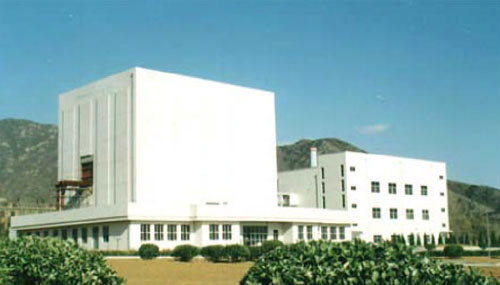 The HRT-10 Pebble Bed Reactor in China first achieved a self-sustaining nuclear reaction in December 2000 and was synchronized to the electric grid in January 2003. It is a research reactor capable of producing 4 megawatts of power. |
The fuel performance modeling is expected to be used to design and—working with a manufacturer—optimize the performance of new advanced fuel particles for use in high-temperature reactors. The air ingress modeling is presently being benchmarked against tests and will ultimately be used to understand the details of the chemical reactions under accident conditions in a full-sized pebble bed or prismatic high-temperature reactor. The modularity work will identify how such a concept can be used to design and build small reactors. The modularity approaches have been compared with the construction of nuclear submarines at both Newport News Shipyard and the General Dynamics Shipyard in Quonset Point, Rhode Island. Based on these site visits and consultations, the approach being proposed appears quite practical and viable.
Advanced Lead-Bismuth Cooled Reactors
Professor Todreas continued to lead the design studies of a large power rating lead-bismuth eutectic cooled fast-spectrum reactor aimed at both low electricity production cost and actinide destruction, which is being designed in collaboration and with the sponsorship of INEEL. Professor Ballinger conducted an experimental program on the corrosion of various steels in contact with lead-bismuth. The results show that the inclusion of silicon in the steel greatly reduces the corrosion in the temperature range of 450° to 650° C. These studies were partially sponsored by the Power Nuclear Corporation of Japan.
Advanced Reactor Research: Gas-Cooled Fast Reactor
Gas-cooled fast reactors (GFRs) provide the combined advantage of much higher fuel utilization and also higher thermal power conversion efficacy than current commercial reactors. Early work under Professor M. Driscoll and Dr. P. Hejzlar led to the successful proposal to include this concept in the DOE list of preferred future GEN IV reactors. The department currently has five separate but coordinated research projects dealing with GFR development. The principal area of work encompasses the full scope of concept development. Others include the design of a supercritical CO2 Brayton power cycle, which achieves high (~45 percent) thermodynamic efficiency at modest core outlet temperatures (550˚ C); material corrosion tests in CO2 in both laboratory rigs and in an in-pile loop in the MIT Research Reactor; PRA-guided design of key reactor plant systems—the postaccident decay heat removal system in particular—for which thermal-hydraulic design is also a project focal point; and, finally, core reactor physics design. The effort includes optimization of neutronics to—among other goals—minimize coolant void reactivity and to prove-out the practicality of "breed and burn" operation, in which high uranium utilization is achieved without the requirement for fuel reprocessing.
Space Power Reactors: Mission to Mars Project
As part of the spring design project in the Nuclear Engineering Department, the challenge of developing nuclear power sources for the proposed manned mission to Mars was undertaken as a design course project under the guidance of Professor Kadak. NASA has recognized that such a mission will require the use of nuclear reactors to provide the power for the electric propulsion ion or plasma engines as well as for the electricity needs of the Mars surface base. The students in the course developed conceptual designs for two unique reactors for the propulsion system and the surface plant. For example, the Mars surface plant uses the carbon dioxide gas in the Martian environment as the coolant for the nuclear plant, saving the need to carry the mass to Mars. The nuclear power plant for the propulsion system uses constituents of used light water reactor fuel as the fuel source for the power plant. The work was performed in collaboration with MIT's Department of Aeronautics and Astronautics.
Nuclear Energy for Hydrogen Production
High-temperature gas reactors have been selected by the Department of Energy as their high-priority technology for the next generation of nuclear plants. These plants are uniquely suited for hydrogen production using thermo-chemical and thermo-electrical technologies because of their high temperatures of operation. Hydrogen energy development has also become a national priority. The department is uniquely positioned to participate in this exciting new developing area due to the experience it has in gas-cooled reactor design and analysis. Professors Kazimi and Driscoll and postdoctoral associate Bilge Yildiz have initiated a study of the efficiency and economic potential of various reactor and chemical technologies for hydrogen production. Preliminary estimates suggest that high-temperature electrolysis from a plant using a supercritical CO2 gas turbine coupled to an advanced gas-cooled reactor (which operates at a maximum coolant temperature of 650° C) is very promising. It could be competitive with the hydrogen production from a helium-cooled reactor driven by a thermo-chemical sulphur-iodine cycle for water splitting (which requires operation above 850° C).
High-Efficiency Annular Fuel for Light Water Reactors
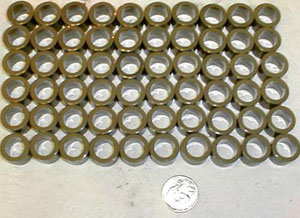 Fuel pellets manufactured for the High Performance Annular Fuel Project by Westinghouse, a partner in the DOE-supported project. |
The use of annular fuel instead of the conventional solid cylindrical fuel in LWRs has been under investigation by Professor Kazimi and Dr. Pavel Hejzlar. The internally and externally cooled fuel increases the fuel heat transfer surface-to-volume ratio, thus leading to significantly lower fuel temperatures. This DOE-supported project aims at investigating the ability to raise the power extracted from the core while maintaining or improving thermal margins. Fuel manufacturing techniques are being investigated with industrial collaborators Gamma Engineering and Westinghouse. Thirty fuel pellets were manufactured to ascertain the feasibility of production of pellets with small tolerances using traditional sintering techniques. In addition, fuel segments made by vibrational packing are being investigated with support from Atomic Energy of Canada.
Radiation Science and Technology
Quantum Information Processing
Professor Cory and his students continue to explore nuclear magnetic resonance (NMR) approaches to quantum information processing (QIP) through a set of collaborations with Dr. Timothy F. Havel (NED), Dr. C. Ramanathan (NED), Professor Seth Lloyd (Mechanical Engineering), Professor Eddie Farhi (Physics), Dr. Raymond Laflamme (University of Waterloo), Dr. E. Knill (Los Alamos National Laboratory), and Dr. J. Yepez (Air Force Research Laboratory). The last year's work has resulted in an improved understanding of coherent control for incoherent systems, better models of decoherence for quantum information processors, and the introduction of statistical measures of control. We have initiated studies of coherent control in electron/nuclear spin systems and have proposed a program of coherent control between ensembles of nuclear spins and cavity modes of a coherent superconducting oscillator.
NMR of Heterogeneous Semisolids
In collaboration with Dr. S. Singer (Memorial Sloan-Kettering Cancer Center), Dr. Pabitra Sen (Schlumberger Doll Research Laboratory), and Dr. R. Walsworth (Harvard Smithsonian), we have continued to explore the structure and fluid dynamics of complex media. This work has applications from soft-tissue sarcomas to enhanced oil recovery.
NMR Resource for Neuroscience
In collaboration with the McGovern Institute, we have started to assemble a magnetic resonance imaging (MRI) resource for MIT faculty engaged in neuroscience (or more generally, for small animal imaging). This builds on our development of an NMR microscope (with Dr. Alan Jasanoff, a Whitehead fellow) and includes the further development of animal imaging capabilities on a 4.7 T 40-cm bore MRI. We plan to add a higher field (9.6 T) imaging system optimized for mice.
Research in Professor Coderre's laboratory continues in two main areas: boron neutron capture therapy (BNCT) and the basic radiation biology of alpha particles. The BNCT project focuses on measuring the sensitivity of the normal lung to the high linear energy transfer radiations produced during BNCT. This project is also investigating the mechanisms by which radiation causes damage in the lung and will explore possible biochemical approaches to reduce these side effects. The methodology has been established to measure breathing rates in rats following whole-lung irradiation. Rats have been irradiated with 250 kVp x rays and in the thermal neutron beam of the MIT Reactor. Professor Coderre works with Professor Harling on one task of the DOE–funded "Innovations in Nuclear Infrastructure and Education" grant: to make the MIT Reactor into an outside user facility for BNCT preclinical radiation biology.
Alpha particle sources have been developed and characterized for irradiation of cells in culture. A method has been developed to partially shield the cells to allow studies on the "bystander effect." Studies are underway to investigate possible synergistic effects between alpha particles and chemotherapy agents and to study the mechanisms of this signaling. This system will simulate radioimmunotherapy, where alpha-emitting nuclides attached to monoclonal antibodies are delivered nonuniformly to the surface of a tumor metastatic site, and will allow systematic studies on ways to improve prostate tumor therapy.
The alpha particle sources form the basis for several collaborations between Professor Coderre and faculty in other MIT departments. He is a coinvestigator on a recently funded National Institutes of Health (NIH) grant awarded to P. Dedon, Biological Engineering, to look at the effects of alpha particle radiation on DNA. Professor Coderre is also a coinvestigator on an NIH grant submitted by K. Dane Wittrup, Chemical Engineering, on ways to improve the use of alpha particles attached to monoclonal antibodies for targeting metastatic tumor cells.
Patient accrual has started for the new Phase I/II trials of neutron capture therapy. The new fission converter–based epithermal neutron irradiation facility has been used for these irradiations, and it has functioned flawlessly. Professor Harling's group made a series of presentations at the 10th Congress of the International Society of Neutron Capture Therapy, including his own presentation of the lead plenary session paper.
A new DOE–supported project has been initiated that supports the use of the neutron capture therapy facilities at the MIT Reactor for non-MIT users. This is the only national user facility offering neutron irradiations to outside users.
Radiation Damage and Nuclear Waste
Professor Hobbs shifted his effort from studying radiation-induced amorphization in silica and silicate solids to amorphization of silicon carbide (SiC), a compound likely to appear in near–first wall structural applications in fusion reactors. He and Dr. Xianglong Yuan (postdoctoral assistant) have shown, using molecular dynamic topological modeling, that the surprisingly facile amorphization of SiC is driven by chemical disorder, which they demonstrate induces an actual reversible glass transition above a chemical disorder threshold. The finding has implications for predicting swelling of irradiated SiC, which derives largely from induced chemical disorder before the amorphization threshold is reached. Professor Hobbs and Dr. Yuan have also applied their topological methods, collaboratively with researchers at the Pacific Northwest National Laboratory, to the definitive identification of point-defect configurations in rapidly amorphizing SiC, in which a crystalline reference lattice has been effectively lost.
Professors Hobbs and Yip are participating, together with counterparts from the University of Cambridge, in a new Cambridge-MIT Institute (CMI) program on nuclear waste encapsulation in ceramic media. The aim of the three-year program, which also involves substantial support from British Nuclear Fuels Ltd., is to significantly improve design and radiation resistance of crystalline ceramic nuclear waste media for high-level nuclear waste and actinide storage through studies using modeling and experiment.
Contraband Detection
The events of September 11 have led to an increased interest in Dr. Richard C. Lanza's work on explosive and contraband detection. This has resulted in a significant expansion in funding for our work in neutron resonance radiography from the Technical Support Working Group, an interagency co-coordinating organization, as well as a new effort with the Lawrence Livermore National Laboratory in detection of potential radiological or nuclear weapons.
Neutron Resonance Radiography
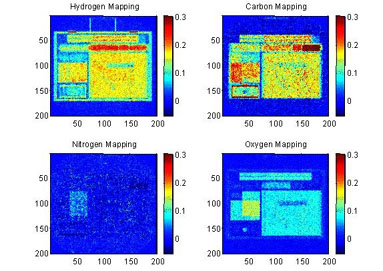 Elementally resolved images of a small suitcase containing various contraband materials. |
We have developed a new method for detecting materials based on neutron resonance radiography. This technique is capable of good spatial resolution (~ 3 mm) and penetration of heavy objects, as well as of determination of elemental composition. Element-specific resonances in total neutron attenuation cross-sections, which are in the 1-to-8 MeV range, are exploited to enhance the contrast for imaging elements such as carbon, oxygen, nitrogen, and others. This is then used to produce elementally resolved images of objects under inspection and thus to identify the material composition of the object and to identify potential threats in an unambiguous manner.
Passive Detection of Fissile Materials
Recent events highlight the increased risk of an attack on the United States with a nuclear or radiological weapon. One of the key needs to counteracting such a threat is the long-range detection of nuclear material. Theoretically possible to distances greater than 100 m based on gamma-ray emissions from such materials, detection at such distances has long been thought to be impractical due to fluctuating levels of natural background radiation. Recent work has shown that this problem can be overcome through the use of imaging gamma-ray detectors based on our work in coded apertures. In collaboration with Lawrence Livermore National Laboratory, we are constructing a prototype system capable of detecting such materials. Berthold Horn of the Artificial Intelligence Laboratory is another collaborator.
Intense Neutron Sources
This program is a collaboration between MIT and the Lawrence Livermore National Laboratory for the development of intense, bright neutron sources, primarily for use in high-resolution fast neutron radiography. We have made progress in the development of windowless targets for this application and have identified limitations on beam size and intensity for various approaches. Fast neutron radiography is a potential method for nondestructive examination of large, dense structures that are not accessible by other techniques.
Neutron Phase Contrast Imaging
In collaboration with researchers at the National Institute of Standards and Technology, we are designing and constructing an imaging system that uses the wave properties of thermal neutrons to produce phase-shift contrast images. This approach greatly enhances the contrast of small defects and features; initial estimates are that this technique may be as much as 1,000 times more sensitive than conventional radiography. We are presently evaluating detectors using a beamline at the MIT Nuclear Reactor Lab.
Medical Imaging
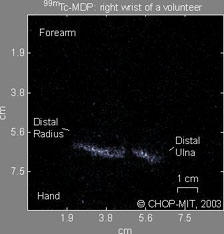 First patient image, that of the forearm of a volunteer showing the clear separation between radius and ulna growth plates made possible by improved resolution. |
We have continued our work in coded aperture nuclear medicine imaging. This technique provides simultaneously enhanced resolution and sensitivity as compared to conventional nuclear medicine imaging methods. Our collaborators are the Center for Molecular Imaging Research at Massachusetts General Hospital, Beth Israel Deaconess Medical Center, and Children's Hospital of Philadelphia. Currently we are imaging small animals and a limited number of pediatric patients on an experimental basis. We have achieved spatial resolutions of 0.9 mm using standard nuclear medicine gamma cameras. With new three-dimensional reconstruction techniques developed in collaboration with Dr. John Idoine of Kenyon College, we have shown the ability to provide full three-dimensional images from a limited number of views as compared to conventional SPECT imaging, thereby considerably reducing dose to patients.
Fusion
The Alcator C-Mod Experiment
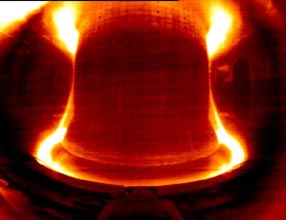 A wide-angle view of the Alcator C-Mod Plasma. |
The Alcator C-Mod tokamak is a major international fusion experimental facility, directed by Professor Ian Hutchinson. Research continued in high-performance, compact magnetic plasma confinement. The upgrade to permit quasi-steady-state exploration of advanced tokamak operation with high fractions of self-generated current, under the leadership of Professor Ronald Parker, is now complete. The 4.6 GHz high-power radio-frequency sources are installed, and the wave launcher, fabricated by collaborators, is undergoing rework before installation.
During the past academic year, the five-year proposal for grant renewal was prepared, submitted to the DOE, and reviewed by an external panel. The reviews were very favorable and renewal is scheduled for December 2003.
On his appointment to head the Nuclear Engineering Department, Professor Hutchinson handed over administrative direction of the Alcator project to Dr. Earl Marmar while remaining a coprincipal investigator and actively involved in the research.
C-Mod is recognized as one of three major US national fusion facilities. The team includes approximately 16 MIT staff scientists, 18 MIT graduate students, 18 engineers, and 25 technicians. In addition, we have collaborators from around the world, bringing the total number of scientific users of the facility to about 120.
The Office of Fusion Energy Sciences of the US Department of Energy put forward a plan for substantial increases in funding for FY2003. The presidential budget proposed an increase of approximately $4 million for the facility to enable a major increase in operations time, moving toward full utilization. Unfortunately, the continuing resolution federal budget and subsequent funding shortfalls substantially eroded the increase, allowing only 13 weeks of research operations. The FY2004 presidential budget again includes further increases that would enable 21 weeks of operations.
Following are highlights of recent research achievements.
Major progress has been made in the use of radio frequency waves to control and heat the plasma. We use waves in resonance with the cyclotron motion of ions about the magnetic field. These waves are our main heating source in high-performance plasmas. A third antenna that had been limited in the power it could deliver was redesigned and then proved capable of approaching the targeted power capability. Its advantages, compared with our earlier designs, are that it uses less port space and that it launches waves whose direction of propagation can be adjusted. We have begun experiments directing the waves either parallel or antiparallel to the plasma current and thereby demonstrated the ability to influence the stability of the plasma core. Longer term, this antenna will be used to investigate the ability to drive electric current and plasma flow.
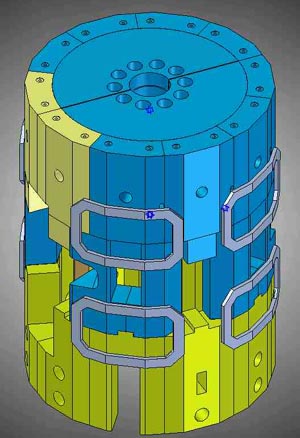 New set of asymmetric magnetic field coils on Alcator tokamak. |
During the winter, a new set of asymmetric magnetic field coils was installed on the tokamak. Its purpose is to compensate or impose small perturbations of the field that when resonant with the mean field lines cause magnetic islands to form. The magnetic islands cause a viscous drag on the usually flowing plasma and, when sufficiently large, can brake the plasma until it becomes stationary or "locked." This is usually unfavorable, but it has been difficult to predict for a large next-step device such as the International Thermonuclear Experimental Reactor (ITER) how large a perturbation is tolerable. Some scalings based on results from low-field tokamaks predicted very stringent limits on permissible field errors for ITER. By deliberately applying perturbations on C-Mod, we have obtained values for the field error necessary to lock the plasma (typically 10-4 of the main confining field). These values overthrow the previous scaling and indicate that ITER will require no extraordinary measures for maintaining low enough error fields.
Several important collaborative experiments were carried out this year on the Alcator in coordination with other facilities. These experiments seek to understand the complicated physical processes governing transport through the use of dimensionless similarity. Plasmas that have similar dimensionless parameters (such as the ratio of plasma radius to ion gyro orbit size) as well as shape are created on different devices. Our collaborating facilities include DIII-D at General Atomics, San Diego; JET at Oxford, UK; and Asdex Upgrade, Garching, Germany. We have established that the edge of the plasma, where a steep gradient in density and temperature exists, does follow the dimensionless scaling appropriate to being governed by simple plasma physics, and it does not therefore seem dominated by atomic physics. The Alcator is a crucial partner in such experiments because of our high magnetic field and compact size.
The neutral beam installed last year has operated successfully, and diagnostics that use it have begun to yield important information on the internal magnetic field structure and on density fluctuations caused by plasma turbulence. Because this beam is on loan from the University of Padua and has to be returned next year, we are procuring a new beam of our own. It will have improved parameters, including a long pulse appropriate for our plasma, and higher current density to enhance signal-to-background.
Student Awards and Activities
A number of students were recognized at the Annual International Dinner/Awards Ceremony in May 2003.
- Cara Toretta received the Irving Kaplan Award for academic achievement by a junior in nuclear engineering.
- Catherine Goff received the Roy Axford Award for academic development by a senior in nuclear engineering.
- Graduate students John Koser and Vaclav Dostal shared the Outstanding Service Award in recognition of exceptional services to the students, the department, and the entire MIT community.
- Graduate students Suchandra Ghosh and Hongyu Jiang shared the Outstanding TA Award in recognition of exceptional services to education by a teaching assistant.
- Mark Khachaturian was selected as a recipient of the 2003–2004 Alumni Network Services (ANS) Graduate Scholarship Award for a student entering the field of nuclear science and engineering. This scholarship is selected by the Scholarship Subcommittee of the ANS Education and Training Division.
More information about the Department of Nuclear Engineering can be found on the web at http://web.mit.edu/ned/www/.